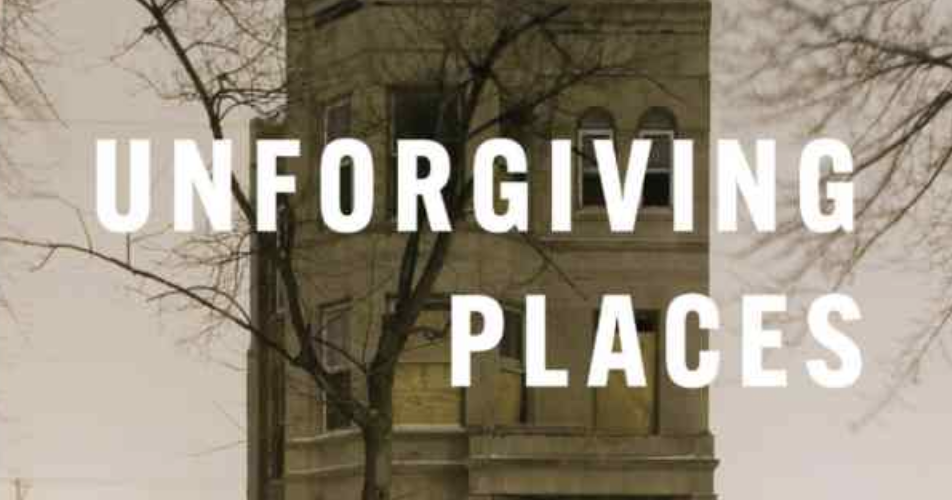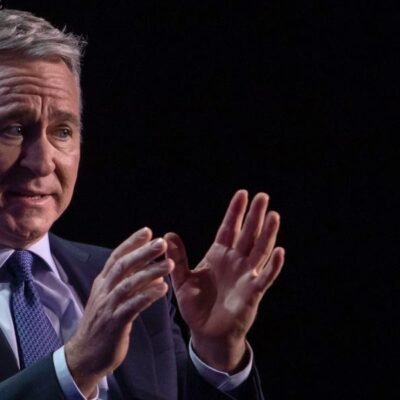For decades, Chicago has existed in the popular imagination as a city so fraught with gun violence that one of its derogatory monikers, “Chiraq,” likens the city to Iraq, the war-torn Middle Eastern country where, in the mid to late 2000s, death and destruction were commonplace under the American-led occupation.
President Donald Trump referenced inner cities like Chicago in his first inaugural address as exemplars of the “American carnage” that he said necessitated the sweeping set of policy changes falling under his catchall slogan “Make America Great Again.”
Mayor Brandon Johnson similarly sounded the alarm about the toll of gun violence on the city in his May 2023 inaugural speech, warning that Chicagoans might become so “overwhelmed by the traumatization of violence and despair that our residents felt no hope or no choice but to leave.”
Unlike other major American cities like New York and Los Angeles, which have seen gun violence decline precipitously to historic lows since the 1990s, the perception of Chicago as a city especially beset by gun violence is not simply an outdated or politically motivated viewpoint.
This year so far, 149 people were fatally shot and 591 more were shot and survived. The city’s homicide rate remains stubbornly higher than that of comparable cities in other wealthy, industrialized countries — and this is true despite a 42% drop in shootings from this time last year, according to the Mayor’s Office’s Violence Reduction Dashboard.
Whereas the murder rate in Chicago is about 30 per 100,000 residents, in Toronto the murder rate is a tenth of that: just three per 100,000 residents. In Casablanca, one of Chicago’s sister cities, the rate is even lower: two per 100,000, according to the most recent UN data.
And the impacts of shooting homicides aren’t limited to shooting victims; the trauma radiates outward. According to one study, violent homicides in the U.S. account for the vast majority of the social costs of crime, although they make up only a small percentage of the overall number of crimes committed.
One immediately apparent answer to addressing the issue is to do away with or significantly restrict access to guns — Canada’s rate of gun ownership is about a third of the rate in the U.S.; Morocco’s is 4%. By removing gun homicides from the U.S. totals, the country’s murder rate is nearly identical to that of wealthy peers like the United Kingdom, France or New Zealand. Guns, it seems, are a category apart from other weapons because of their lethality and the ease with which they can be concealed.
But with Republicans ascendant in the White House and commanding majorities in Congress and on the bench of the Supreme Court, meaningful gun control legislation or court rulings appears to be a remote — if not distinctly unfathomable — possibility.
So, what to do about gun violence in the absence of meaningful gun control in the near future?
On the right, the response to violence has been a combination of heightened surveillance and a series of ever-more draconian punishments — more police, more jails, more prisons, longer prison sentences — to deter or indefinitely detain those they consider characterologically bad people.
To the left, the answer has instead been to address the “root causes” of gun violence — namely poverty, divestment and unemployment — through increased social spending. The theory behind this approach is that but for want, opportunity and social isolation, shootings would not occur.
But according to a new book by University of Chicago public policy professor Jens Ludwig, both sides of the political spectrum are (somewhat) wrong with regard to their paradigmatic prescriptions for stemming the tide of gun violence in America. In “Unforgiving Places: The Unexpected Origins of American Gun Violence,” Ludwig argues that behavioral economics “provides a new way to understand — and, to the extent possible, solve — this quintessentially American problem.”
To the right’s argument that violence is driven by “incorrigibly wicked people,” Ludwig responds in a typically wonkish manner that this “doesn’t fit basic facts, such as ‘the steady decline in criminal offending starting in late adolescence … or the remarkable variation of gun violence by time.’”
“Nor can it explain,” he continues, “why gun violence varies so dramatically by place, including across very short distances — such as across Dorchester Avenue, separating Greater Grand Crossing from South Shore, since surely people’s morality cannot be so sharply different literally across the street.”
Ludwig uses this example to also counter the left’s argument. If poverty is the primary cause of shootings, why then is the rate of gun violence much higher in Greater Grand Crossing than in South Shore? Both neighborhoods have similar median incomes, racial demographics and are physically proximate, he points out.
“All rich neighborhoods are safe. And every high-violence neighborhood is poor,” he writes. “But there is enormous variability across equally low-income neighborhoods in Chicago in their rates of gun violence.”
And while Ludwig wholeheartedly agrees that addressing poverty, segregation and discrimination are socially vital goals, he says they’ve proven incredibly difficult for the country, let alone Chicago, to solve.
“We can’t just focus on trying to change these big, hard-to-change root causes,” he writes. “That’s a recipe for subjecting millions of people living in the country’s most distressed, disadvantaged, segregated communities to decades more of unrelenting gun violence. We need to try something new.”
The central issue, Ludwig argues, is that we’ve mistakenly assumed most shootings stem from a rational cost-benefit analysis of the perceived benefits and costs of crime, and that by toggling either the former or the latter of these levers, shootings will drop. But, he explains, the data suggest that most murders stem from heated arguments, which are not amenable to such deliberate calculations.
“So-called criminal behavior turns out to be — surprisingly — not that different from everyday human behavior: bad decisions made under stress in difficult situations,” Ludwig writes.
Ludwig has long studied this problem as head of the U. of C.’s Crime Lab, which has drawn criticism from some community organizers and scholars for what they see as an overly cozy relationship with law enforcement and city officials. And despite his avowedly good intentions, this proximity to power demands extra scrutiny, particularly given his book’s quantitative emphasis and relative lack of close ethnographic study of South Shore and Greater Grand Crossing, the two Chicago neighborhoods he singles out repeatedly to illustrate his central argument.
Drawing on the work of Nobel Prize-winning economist Daniel Kahneman, the so-called “grandfather of behavioral economics,” Ludwig contends that much violence stems from common, recurrent problems with System 1 thinking, which is fast, emotional and unconscious — as opposed to System 2, which is slow, methodical and logical.
While the former is an extremely useful adaptive tool in low-stakes, routine situations, it becomes a liability in high-stakes, non-routine moments that could use more System 2 deliberation — such as heat-of-the-moment arguments in which one of the parties has a gun.
It is worth noting that while behavioral economics has illuminated how humans often fail to act in perfectly rational ways, as was long assumed by economic theorists, the field has faced criticism for its overreliance on lab-based experiments that may not translate well to complex, real-world social dynamics, such as in marginalized communities shaped by systemic violence and disinvestment.
And skeptics have also warned that behavioral “nudges,” like those Ludwig favors, risk individualizing social problems, focusing on cognitive tweaks rather than confronting the political and structural conditions that create difficult neighborhood environments in the first place.
But Ludwig doesn’t just rely on economic thinking alone; he also draws extensively from urban theorist Jane Jacobs to argue that these problems are exacerbated by certain neighborhood conditions — such as a lack of informal social control, i.e., fewer “eyes on the street,” which she identified in her landmark 1961 book “The Death and Life of Great American Cities” and on-the-ground collaborators like Dr. Chico Tillmon.
While these conditions often exist in poor neighborhoods, some, Ludwig writes, have greater or lower levels of informal social control. This, he argues, explains the variation in gun violence between South Shore and Greater Grand Crossing: “The more limited informal social control in Greater Grand Crossing means that neighborhood is more unpredictable, provides less feedback, depletes people’s mental bandwidth due to higher levels of stress and trauma, and requires more reliance on self-help for protection that leads to higher levels of gun carrying — raising the stakes for System 1 errors.”
What this implies, he writes, is that “while society is trying to address the big, difficult-to-solve root causes of the gun violence problem — income and racial segregation, social isolation, discrimination — there are other neighborhood factors that policy can productively target to reduce gun violence in the near term.”
The policies Ludwig recommends range from more small businesses and pocket parks to fewer illegal guns on the street, better street lighting, more paid violence interrupters and programs like restorative justice that help people think about their thinking. None of these approaches try to change people’s character or necessarily increase incomes, but all of which raise the level of informal or formal social control in a neighborhood, teach metacognitive skills or reduce the likelihood of someone possessing a weapon when an argument turns heated.
These aren’t new ideas, Ludwig admits, but behavioral economics provides a framework for why they work — and suggests that scaling them up can and will yield meaningful results in terms of reducing gun violence.
“Progress is possible by changing the decision-making environments that people have to navigate, and by directly helping them to better navigate those difficult situations,” Ludwig concludes. “To make, in other words, more of our unforgiving places into forgiving ones.”
“Unforgiving Places: The Unexpected Origins of American Gun Violence” by Jens Ludwig. University of Chicago Press, 394 pp., $27.50 (hardcover).





